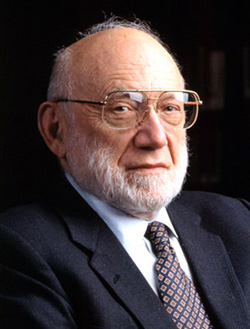February 5, 2008 - By Amy Adams

Joshua Lederberg in 2001.
Joshua Lederberg, PhD, winner of the 1958 Nobel Prize for his discovery of how bacteria transfer genes, died Feb. 2 of pneumonia. He was 82.
Months after winning the Nobel Prize, Lederberg arrived at the Stanford University School of Medicine to become the chair of genetics in 1959, after leaving his post at the University of Wisconsin. He led Stanford's genetics department at a time when the medical school earned a reputation for research, until he left in 1978 to become president of The Rockefeller University in New York until 1990.
Lederberg shared the Nobel Prize in Physiology or Medicine with Edward Tatum and George Beadle. His portion of the prize came from his discovery that bacteria transfer genetic information, overturning the prevailing thought that bacteria weren't able to swap DNA. Lederberg found that bacteria exchange loops of DNA called plasmids that allow bacteria to pick up new genes, and thereby adapt to new environments. The process Lederberg discovered has become a standard way for researchers to transfer genetic information between bacteria in the lab, and changed how researchers thought about infectious disease. It also laid the foundation for modern molecular biology, genetic engineering and biotechnology.
Lederberg was only 33 when he came to Stanford, but he already had a long research career that began in high school.
His father was a rabbi, and when Lederberg was a teen he promised to aid humanity through science rather than faith. He began doing independent research at the science-focused Stuyvesant High School, then continued that research as an undergraduate student at Columbia College. After starting medical school at Columbia University's College of Physicians and Surgeons he left after two years to pursue a PhD at Yale, working with Tatum and Beadle on studies that led to their shared Nobel.
The year Lederberg arrived to head Stanford's genetics department was a pivotal one in the medical school's history. The school was in the process of moving from San Francisco to join the Stanford campus in Palo Alto. During that same time period Arthur Kornberg, PhD, who went on to win the 1959 Nobel Prize in Biochemistry, arrived to found Stanford's biochemistry department. The departments led by Kornberg and Lederberg helped establish the medical school as a leader in biomedical research.
'Dr. Josh Lederberg was one of the greatest scientists of the 20th century with staggering achievements from bacteriology and microbiology to genetics and planetary exploration,' said Philip Pizzo, MD, dean of the medical school. 'He was not only a world-renowned scientist but also an advocate on science and public policy. His impact on Stanford can be felt to this day and will surely continue long into the future.'
Throughout his career Lederberg had interests that strayed far from the laboratory bench. The launch of Sputnik in 1957 led Lederberg toward an interest in astronomy that lasted 20 years. His concern about the risk of spacecraft returning to Earth with contaminants from space resulted in a quarantine for space travel that remains in effect today. He went on to design experiments intended to detect the presence of life on Mars, resulting in the Mars Viking lander.
Lederberg became increasingly aware of the value of computers. He formed collaborations with researchers at Stanford to create a program for analyzing mass-spectrometric data of molecular structures, called DENDRAL, which led to further programs for disease diagnosis and management.
These wide-ranging interests were a hallmark of Lederberg's intellect, according to Paul Berg, PhD, emeritus professor of biochemistry and Nobel Prize winner. 'What was extraordinary is that he was at home in so many areas,' Berg said. 'He made one of the really major discoveries that paved the way for modern genetics, but then he ventured into areas that were entirely different.'
Lederberg stayed true to his teenage promise to aid mankind. Concerned about the public's awareness of science, he wrote a weekly science column in the Washington Post from 1966-71. Among the topics he addressed were infectious disease outbreaks and biological weapons, both of which were interests that he also pursued through his academic work. He served on national committees for biological weapons and became a national arms control advisor. These interests also led to collaborations with Stanford political scientists and physicists, which eventually resulted in the creation of an undergraduate curriculum in national security and arms control.
Lederberg left Stanford in 1978 to become president of Rockefeller University. While there, he continued his research and, despite retirement in 1990, worked internationally to prevent the use of biological weapons. He also served on the executive committee and as a consulting professor at Stanford's Center for International Security and Cooperation.
Over the course of his life, Lederberg was elected to the National Academy of Sciences, the Institute of Medicine, received the National Medal of Science, was named an honorary life member of the New York Academy of Sciences, was awarded Foreign Membership of the Royal Society of London and holds the title of Commandeur, L'ordre des arts et des lettres in France.
Lederberg is survived by his wife Marguerite Stein Lederberg, PhD, his son David Kirsch and his daughter Anne Lederberg, and two grandchildren. Funeral services were held Feb. 5.
About Stanford Medicine
Stanford Medicine is an integrated academic health system comprising the Stanford School of Medicine and adult and pediatric health care delivery systems. Together, they harness the full potential of biomedicine through collaborative research, education and clinical care for patients. For more information, please visit med.stanford.edu.